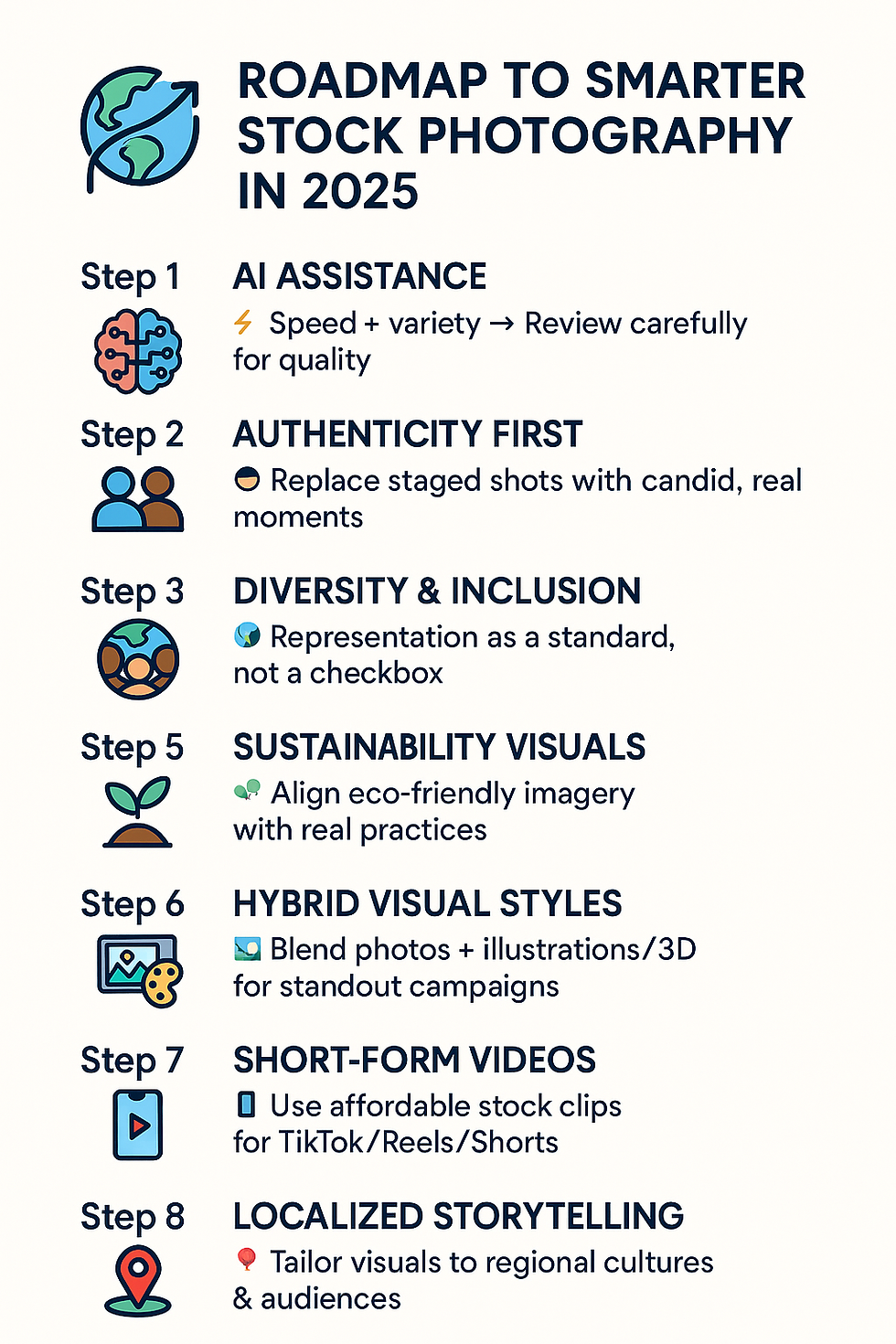Top 8 Stock Photography Trends for Businesses in 2025: What Brands Need to Know
- Nikhil Garg
- Aug 27
- 7 min read
Introduction
For years, stock photography had a reputation for being generic—think staged boardroom handshakes, forced smiles, or unrealistic office settings. But those days are gone. In 2025, businesses are relying more than ever on stock imagery, but in ways that are smarter, more authentic, and aligned with their branding.
With digital marketing competition growing, visuals are no longer “just filler.” They are storytelling tools that help a brand connect with its audience instantly. Choosing the wrong kind of image can make your business look outdated or disconnected, while the right stock visuals can boost engagement, build trust, and drive conversions.

This blog explores the Top 8 stock photography trends for businesses in 2025, with real-world examples, case studies, and a look at what the future holds.
1. AI-Assisted Stock Photography
AI-generated stock photos are now a mainstream option. Businesses use them to create highly specific, on-brand visuals at a fraction of the cost of traditional shoots. AI tools also allow businesses to test multiple creative concepts simultaneously. For example, marketers can generate different ad visuals targeting unique demographics and run A/B tests instantly. This speed and adaptability make AI stock imagery a game-changer for time-sensitive industries like e-commerce and events.
Business angle: Saves money, custom visuals faster, and endless variety.
Case in Point: A digital marketing agency used AI-assisted images to create seasonal campaigns in multiple languages. Instead of waiting weeks for custom shoots, they generated culturally tailored visuals in hours, reducing campaign turnaround by 60%.

Key Tip: Always review AI-generated stock carefully—watch for anatomical mistakes or odd details that could hurt brand credibility.
2. Authentic Brand-Driven Visuals
Authenticity sells. Businesses want stock photos that look like they came from real workplaces, real people, and real moments. Authentic visuals also reduce the risk of looking outdated or fake. Customers today value transparency, so businesses that showcase realism in their visuals naturally earn credibility. Even if stock photos are used, choosing ones that mimic daily scenarios—like brainstorming sessions or casual networking—creates stronger emotional connections.
Business angle: Boosts relatability and trust.
Mini Case Study: A SaaS startup noticed poor performance with traditional “business handshake” stock photos. They switched to candid images showing actual employees collaborating. Their LinkedIn campaign’s click-through rate increased by 42% in three months.

Key Tip: Pick images that reflect your real audience—use visuals that feel like a mirror, not a stereotype.
📎 Keyword planner for entire year
Packed with actionable tips for Shutterstock success, niche ideas, and automation tools for contributors.
3. Diversity & Inclusion as a Standard
Representation has shifted from a “nice-to-have” to a non-negotiable. Businesses actively seek stock that reflects people of different ethnicities, genders, ages, and abilities. Using diverse visuals can also expand market reach. Campaigns that show inclusivity resonate with underrepresented groups and enhance brand loyalty. From a business standpoint, this creates a competitive edge by aligning the brand with global values and widening the customer base.
Business angle: Builds trust and global relevance.
Example: A corporate training firm updated its visuals to show diversity in leadership roles—women, older professionals, and differently-abled employees. This helped reposition the brand as inclusive, leading to stronger client adoption.

Key Tip: Don’t just add diversity as a checkbox. Ensure images show genuine interaction and inclusivity.
4. Workplace Culture & Hybrid Work Settings
The workplace is no longer a single office—it’s hybrid, flexible, and digital. Businesses are now using stock photos that reflect this reality: remote teamwork, co-working spaces, video calls, and casual yet professional work environments. This trend also ties directly into employer branding. Companies that visually highlight flexibility and modern work setups appear more attractive to young talent. Images of employees enjoying collaborative yet balanced environments help position businesses as progressive and people-first.
Business angle: Perfect for employer branding, HR campaigns, and B2B marketing.
Case Example: A consultancy updated its recruitment campaign with visuals of hybrid team meetings instead of only office shots. Applications rose 18% in the first month.

Key Tip: Balance visuals—show traditional professionalism but also the flexibility of remote work.
5. Sustainability & Eco-Friendly Narratives
Sustainability is a powerful business narrative in 2025. Stock imagery that depicts renewable energy, eco-friendly packaging, and green lifestyles is in high demand. Customers are increasingly scrutinizing whether a brand’s visuals align with its actions. That’s why eco-friendly imagery—plants in workspaces, solar-powered offices, recyclable products—works best when paired with real sustainability initiatives. Businesses that get this right not only attract eco-conscious consumers but also build long-term credibility.
Business angle: Signals corporate responsibility.
Mini Case Study: A retail brand ran a campaign featuring sustainable packaging visuals instead of generic product shots. Customers responded positively, with a 12% increase in repeat purchases.

Key Tip: Use sustainability imagery carefully. Match it with your real practices—stock alone won’t cover greenwashing.
6. Hybrid Visual Styles (Photo + Illustration Blends)
To stand out, brands are using mixed media visuals—real photos enhanced with vector art, graphic overlays, or 3D elements. Hybrid visuals also allow brands to differentiate themselves in saturated markets. A balance of photo realism and artistic creativity gives businesses a unique voice. These styles work especially well in industries like tech, finance, and education where abstract ideas need to be communicated visually.
Business angle: Perfect for grabbing attention on social media.
Example: A fintech startup blended real customer images with abstract 3D illustrations to explain complex finance topics in a more engaging way.
Key Tip: Keep it minimal—don’t clutter the image. Aim for a balance between clarity and creativity.

📎 Keyword planner for entire year
Packed with actionable tips for Shutterstock success, niche ideas, and automation tools for contributors.
7. Short-Form Stock Videos for Social Media
Video-first platforms like TikTok, Instagram, and YouTube Shorts are booming. Businesses are leveraging stock video clips to keep up without heavy production costs. Short-form videos also improve SEO and social discoverability. Algorithms favor video, so businesses that use stock clips effectively often get higher reach. By customizing stock videos with subtle branding elements, companies maintain originality without overspending on production.
Business angle: Fast, affordable, and high engagement.
Mini Case Study: A fitness coaching brand added short stock workout clips to their Instagram Reels. Within six weeks, follower engagement increased by 35%.
Key Tip: Add your own captions, brand colors, or voiceover to stock clips to make them original.

8. Localized Storytelling
Global campaigns don’t work everywhere. Businesses now prefer localized visuals that resonate with specific regions or cultures. Localization also strengthens cultural relevance. From traditional festivals to local cuisines or architecture, adding these details to campaigns increases emotional appeal. Stock photos that match local identity help brands connect deeper with their target audience while avoiding cultural disconnect.
Business angle: Makes campaigns feel personal and relevant.
Example: A financial services company in India replaced generic Western stock offices with local business street imagery. Customer trust improved, and lead conversion rose 20%.
Key Tip: Search by region-specific tags when browsing stock platforms.

What Businesses Should Keep in Mind
While using stock photography trends is exciting, businesses should remember a few golden rules:
Stay Authentic: Don’t pick overly polished or “fake” stock.
Prioritize Quality: High resolution and consistent color palettes matter.
Mind the License: Always check usage rights—especially for ads.
Balance Trends: Don’t overdo every trend; pick what fits your brand.
Consistency is Key: Stick to a visual style guide to keep branding strong.

The Future of Stock Photography for Businesses
Looking beyond 2025, stock photography is moving toward even more personalized and immersive experiences.
Interactive Visuals: Businesses may soon use stock that adapts to users—clickable infographics, interactive diagrams.
AR-Ready Content: Augmented reality will demand 3D-ready stock assets for marketing campaigns.
AI Personalization: Stock platforms will generate images based on brand identity (colors, tone, audience) in real time.
Niche Micro-Trends: Hyper-local, hyper-specific imagery will rise, allowing businesses to go beyond generic visuals.
The bottom line? Stock photography is no longer static—it’s evolving into an adaptive, brand-specific resource. Businesses that keep up will have the strongest visual storytelling advantage.

TL;DR
Stock photography is evolving fast in 2025. Businesses are moving toward AI-assisted visuals, authentic imagery, inclusivity, hybrid work settings, eco-conscious themes, photo-illustration blends, short-form video, and localized storytelling. Real case studies show how these trends improve engagement and branding. Additionally, businesses should keep in mind authenticity, legal use, and quality consistency, while also preparing for future shifts like interactive visuals, AR-ready stock, and hyper-personalized AI assets.
📎 Keyword planner for entire year
Packed with actionable tips for Shutterstock success, niche ideas, and automation tools for contributors.
Conclusion
Stock photography in 2025 is not about generic filler images—it’s about storytelling, relatability, and cultural awareness. Businesses that embrace AI visuals, authentic imagery, inclusivity, sustainability, hybrid work culture, and short-form video will connect better with audiences and build stronger brand identities.

The smart move? Stay updated, experiment with new formats, and always align visuals with your brand story. Because in today’s world, a picture doesn’t just say a thousand words—it says everything about your brand.
FAQs| Stock Photography Trends for Businesses
Q1. What’s the biggest stock photography trend for businesses in 2025?
AI-assisted visuals and authentic stock photography lead the way.
Q2. How can businesses avoid looking “generic” with stock photos?
Choose authentic, localized, and diverse imagery instead of overused clichés.
Q3. Do businesses need both stock photos and stock videos?
Yes, videos drive higher engagement, especially on social platforms.
Q4. How important is diversity in stock photography?
Critical—businesses that show inclusivity build stronger brand trust.
Q5. What’s the future of stock photography?
Expect AI-generated, AR-ready, and interactive visuals tailored to business needs.
📎 Keyword planner for entire year
Packed with actionable tips for Shutterstock success, niche ideas, and automation tools for contributors.




Comments